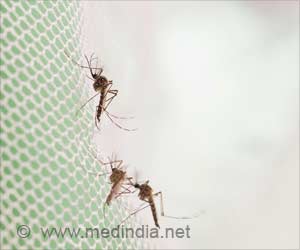Kala azar, a deadly parasitic disease transmitted by the tiny sand fly, has affected an estimated 25,000 people, mostly poor, and claimed 93 lives so far in Bihar.
Kalaazar, a deadly parasitic disease transmitted by the tiny sand fly, has affected an estimated 25,000 people, mostly poor, and claimed 93 lives so far in Bihar. The disease has got 31 of the state's 38 districts in its grip.
Known as the poor man's disease because it affects the poorest of the poor, the disease has affected the little son of Kameshar Manjhi, a poor Dalit labourer in Patna. Manjhi is desperate to earn more money to treat his son and is working through the day and into the night.Manjhi fears his son may die of the disease, that is characterised by fever, weight loss, swelling of the spleen and liver and leads to cardiovascular complications.
The little sand fly that transmits the disease multiplies among the cow dung that villagers use liberally to plaster their shanties or as cow dung cakes for fuel. The flies survive on the sap in banana and bamboo groves and the decomposed cow dung heaps and make their home in the straw thatches of houses.
Like Manjhi's son there are dozens of poor labourers and rickshaw pullers in Tirhut region where most of the deaths have occurred, who are afflicted with the disease.
‘We know that kalaazar affects only poor like us, but what can we do other than pray. Our income is low, not enough to afford the costly treatment for kalaazar,’ Muni Paswan, a rickshaw puller said, adding that in rural Bihar, people were offering prayers and performing rituals hoping to get rid of the disease.
Despite the state government's claims of providing treatment for kalaazar, it still remains a dream for the poor. The disease has affected mostly those from the poorest of the poor belonging to the Musahars, a Dalit community, who fall easy prey to the disease as they are forced by socio-economic compulsions to live in unhygienic conditions.
Advertisement
H.N. Srivastav, deputy director of health, Tirhut division, in his Dec 18 report said that 93 people had died of the disease in October and November. The report said that 9,666 infections were identified in the region during the months.
Advertisement
Ironically, most of the kalaazar deaths were reported from Muzaffarpur and Vaishali districts - 29 died in Muzaffarpur and 35 in Vaishali. Of the rest, 17 were reported from in East Champaran, nine in Sitamarhi, two in West Champaran and one in Sheohar.
According to former central health minister C.P. Thakur, an expert on the disease, more than 50,000 people are suffering from the disease.
Bihar last faced a kalaazar epidemic in 1991 when 250,000 cases were reported. In 2000, the numbers were low but it has been on the rise since 2003.
A new ray of hope to check the spread of kalaazar has come out with the Institute for OneWorld Health, a non-profit pharmaceutical company, announcing an affordable treatment for the disease.
Kalaazar - medically known as Visceral Leishmaniasis - is the second-largest parasitic killer in the world after malaria. The parasite attacks the bone marrow and weakens the immune system leading to increased vulnerability to infections and diseases.
The disease occurs in 62 countries, primarily in the developing world. Around 90 percent of world cases are found in India, Bangladesh, Nepal, Sudan and northeast Brazil. Experts say over 60 percent of the cases in India are found in Bihar alone.
Source-IANS
SRM





